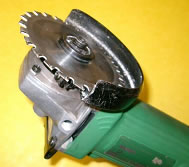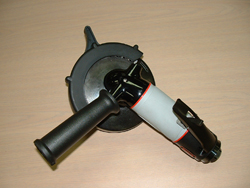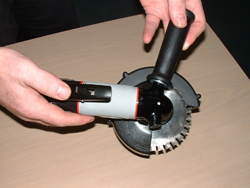Multi-cutters and other discs on power tools and air tools
Published: November 2008
Updated: 22 November 2017
Purpose
The purpose of this safety alert is to highlight hazards associated with multi-cutters and grinding or cutting discs fitted on power and air tools.
Background
Workplace Health and Safety Queensland has investigated a number of serious incidents caused by cutting and grinding discs fitted on hand held power and air tools. Common injuries are amputated fingers, severed tendons and deep cuts to the face, upper body or legs.
Contributing factors
Multi-cutters
Multi-cutters are tungsten tipped saw blades with a diameter of approximately 100mm. Photograph 1 shows a multi-cutter blade fitted to a 100mm angle grinder.
These discs were originally designed to be used on small power saws, not angle grinders. The injuries that can result from using multi-cutters on angle grinders are more serious than those associated with conventional fibre re-enforced cutting discs, because:
- multi-cutters cut through materials at a faster rate
- multi-cutters are more prone to jamming and kickback
- the tungsten tips are sharper and generally cause a wider, deeper, and longer wound
- the tungsten cutting tips can fly off the blade at high speed when the multi-cutter is used as a grinding tool due to the side loading applied to the blade.

Photograph 1 - Multi-cutter fitted to a 100mm angle grinder.
Blades and cup stones
Serious incidents with blades and cup stones include:
- abrasive cup stones exploding causing eye and penetration injuries, similar to bullet wounds
- concrete saw blades jamming on pipes or block work, causing kick-back that results in the worker being hit or cut.
Action required
Multi-cutters
- Angle grinders fitted with multi-cutters should not be used unless they are fitted with full spring loaded guarding.
- The multi-cutter blade is only used on suitable power tools in accordance with the manufacturer's instructions.
- The centre nut securing the multi-cutter blade should be regularly checked for tightness.
- Multi-cutters must not be used for grinding due to the risk of tungsten cutting tips flying off the blade.

Photograph 2 - Multi-cutter fitted with full spring loaded guarding (closed).

Photograph 3 - Multi-cutter fitted with full spring loaded guarding (partially open).
Guards
Spring loaded saw guards, such as those on circular saws, are not readily available for angle grinders. A full guard, referred to as a hood guard, for grinders is shown in photograph 2. A competent person should determine the suitability of the guard for the specific application.
Photograph 3 shows a multi-cutter fitted with full spring loaded guarding (partially open).
General
The points below apply to discs and blades on power tools and air tools.
- The disc or blade manufacturer must supply information that describes the type of power or air tool that is suitable for the disc or blade to be attached to.
- Discs and blades must be marked with the maximum permissible operating speed in revolutions per minute (RPM).
- The power tool must be marked with its maximum operating speed (rated speed) in RPM.
- The rated speed marked on the disc or blade must not be less than the rated speed marked on the power tool.
- The size of the cutting or grinding disc must not exceed that specified by the power tool manufacturer.
- Guards should be provided on all power tools where there is a risk of the disc ejecting, disintegrating or cutting the worker. AS 1788, Abrasive Wheels, provides guidance on guarding abrasive wheels while AS/NZS 60745 Hand-held motor–operated Electric Tools - Safety requirements deals with the safety of grinders, polishers and disc-type sanders.
- Discs must be installed correctly and the centre nut tightened in accordance with the power tool manufacturer's instructions.
- Exclusion zones must be set up around workers so that other people cannot be injured if the worker loses control of the equipment, the disc disintegrates or is ejected.
- Workers must hold hand power tools with both hands as specified by the manufacturer. The worker should preferably stand with both feet on a level surface that is not slippery and operate the tool in front of the body. Heavy and powerful tools should not be used above chest height.
- Workers using a power or air tool must not wear loose clothing or jewellery and must securely tie back long hair so they cannot become caught in a moving part of the tool. Workers wearing protective clothing such as leather aprons and jackets additional to standard personal protective equipment will be better protected from injury when using power and air tools
Further information
Further information can be obtained from the following: